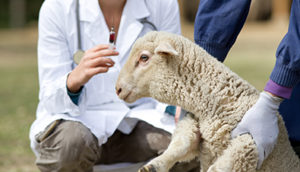Read the latest information on
Foot-and-mouth disease
 If the COVID-19 pandemic has taught Australians anything, it is that maintaining good hygiene practices and minimising the spread of disease are essential in our everyday lives. Throughout the ongoing outbreak maintaining a safe distance from each other, monitoring for symptoms, isolating if we feel unwell and getting tested have helped much of Australia to keep community transmission of the virus to a minimum.
If the COVID-19 pandemic has taught Australians anything, it is that maintaining good hygiene practices and minimising the spread of disease are essential in our everyday lives. Throughout the ongoing outbreak maintaining a safe distance from each other, monitoring for symptoms, isolating if we feel unwell and getting tested have helped much of Australia to keep community transmission of the virus to a minimum.
These same ideas can be applied to the livestock industries, knowing that pest and disease monitoring and good hygiene practices are just as important for maintaining good biosecurity and animal health.
Just as COVID-19 has had a significant impact on our economy, poor animal health and biosecurity management can have a similar result for the red meat and wool industries. It is estimated that endemic diseases and health conditions (i.e. those already found to occur in Australia) cost the sheep industry $2 billion each year, mainly through lost productivity. An emergency animal disease outbreak would have a significantly greater impact, through both productivity losses and the loss of trade in international or domestic markets.
To borrow a phrase from the Australian Government, our message would be this: in order to maintain our clean and green status, the Australian livestock sectors should “stay disease-free and do the three”. Here are three things that any livestock producer can do to minimise their biosecurity risks.
1. Prevent – Much like Australia’s current COVID-19 state and territory border closures, you should consider your boundary fences as your property’s borders and work towards keeping pests and diseases out.
Border patrol activities are necessary for good biosecurity. Checking fences, putting up biosecurity signs, and observing who is entering your property will all help to reduce the risk of unwanted diseases and pests being introduced on to your property.
You can keep your property borders safe by asking vendors for National Cattle or Sheep Health Declarations for any livestock that you purchase. These declarations are designed to provide you, as the livestock purchaser, with the consignment’s disease history and includes any recent treatment or vaccinations that the animals have received. This information is important for monitoring your risk of introducing disease to your farm, and for integrating the new animals into your animal health routine – think of it like a Customs Declaration when you travel overseas!
COVID-19 has seen the introduction a 14-day quarantine period for travellers when arriving in Australia or crossing some interstate borders. Quarantining new livestock arrivals to a property should also be common practice for producers. Keeping the new animals away from existing livestock for a recommended period of 28 days will allow for these animals to be monitored for any signs or symptoms of disease, testing to be conducted and treatments administered if necessary to prevent any potential disease being introduced to the rest of your herd or flock.
2. Prepare – State, territory and the Australian Government have worked tirelessly to ensure that Australia is prepared for further spread of COVID-19, because unfortunately disease spread is at times unavoidable. As a livestock producer you should also be prepared to respond to a possible disease incursion in your herd or flock by creating a biosecurity plan which you can follow to ensure you are able to act swiftly. Regular monitoring of animals can help you detect potential disease outbreaks early, allows for quicker diagnoses and treatment, and will control the spread between animals. Regular testing of your animals can also provide you with valuable information about any underlying health issues that the herd or flock may be experiencing (e.g. a high intestinal worm burden).
If you see any signs or symptoms that are serious or unusual, contact your local vet, animal health officer or call the Emergency Animal Disease Hotline on 1800 675 888 to report and gain support in identifying and treating the disease.
3. Respond – Most Australians recognise the seriousness of the COVID-19 pandemic and have rallied together to contain the spread. Similarly, if there is a notifiable or exotic disease outbreak, everyone in the livestock industry is responsible for ensuring that the disease is contained and managed or, where possible, eradicated. In the event of an emergency animal disease outbreak, livestock standstills may be necessary and each person working in the livestock supply chain should remain vigilant and adhere to the instructions of those responsible for the disease response.
Ultimately, biosecurity is a shared responsibility: whether we’re talking about COVID-19 or the livestock industry, every person and business within our community has the responsibility to ensure they are considering biosecurity risks when carrying out their daily tasks.
Prevention is always better than cure, and if you as a livestock producer take responsibility for implementing sound biosecurity practices on farm, you can enhance the health and welfare of your livestock, improve the productivity and profitability of your business, and support the whole supply chain in continuing to provide a safe and quality product to our domestic and international markets.
For further information on implementing better biosecurity practices on-farm, visit the Farm Biosecurity website or contact Animal Health Australia.